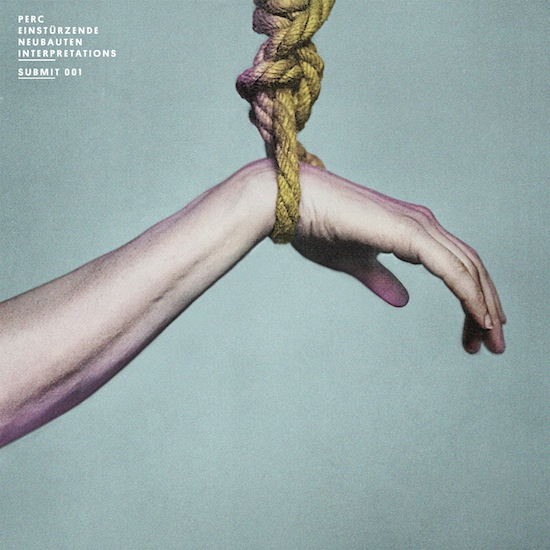Lately we’ve been hearing a resurgence in the impact of abrasive 80s industrial sonics on techno and, vice versa, the influence of techno on what might be considered more traditional ‘noise’-rooted acts like Factory Floor and Vatican Shadow. Ali Wells aka Perc has, from the techno side of things, rather seamlessly welded together the sheer power of the smart end of 80s industrial with 4/4 kick, be it on his brilliant Wicker & Steel LP, the A New Brutality EP, live DJ sets, or remixes for the aforementioned Factory Floor or Dan Avery, among others.
Now, the connection is made explicit again (Wells has, after all, already been remixed by Chris Carter) with one of the heaviest records we’ve heard this year: a collaboration with industrial titans Einsturzende Neubauten. Wells has taken slabs of their early material and applied his own aesthetic – you can hear his sense of menace through space in ‘Liebesdub’, while their shared love of air compressor / kugelhammer violence comes across in ‘Rivieradub’, and the cow-being-hit-by-a-train horror of ‘Lunebest’ has a strange, mordant humour.
The Neubauten collaborations will be the first release on new Perc Trax imprint Submit – we dropped Ali Wells a line to find out more. Listen to samples from Interpretations below, then read our interview about these most exciting of developments.
When did you first become aware of Neubauten? Have you ever seen them live?
Ali Wells: Maybe about five or six years ago. My interest in industrial music deepened, and I started to look beyond the classic UK artists such as Throbbing Gristle, Cabaret Voltaire, etc. Some of what I came across did not appeal but Neubauten and SPK have become firm favourites. I’ve never had the pleasure of seeing Neubauten live, though right now they are a very different live experience to their gigs in the 1980s. To have been present at something like their infamous 1984 ICA show would have been amazing.
How did the collaboration come about? Did you approach them? Were you surprised they were up for it?
AW: I approached them a little after the release of Wicker & Steel. The reaction to the album from areas outside of techno gave me the confidence to make contact with people like Neubauten. They replied quite quickly and were very positive and open to the project from the start. I think they soon realised that I didn’t just want to make club techno versions of their tracks and that there was a lot of love and respect behind the project.
What was your approach? Did you have something specifically in mind that you approached them with? Did the project develop differently to expected?
AW: I really just wanted a fusion of our two sounds, but with my contribution focussing more on my more experimental side. Steering away from making functional techno versions of their tracks meant I was free to do so much more. I tried to imagine what I would have added if I had been there with current technology at the time they had originally recorded the tracks. The project took longer than expected due to the way I edited and extended the tracks, but the final result is close to how I originally imagined it.
Why the decision to largely focus on the early material? Is that the period you’re more into?
AW: Whilst I appreciate much of Neubauten’s back catalogue, their earlier works and especially the Kollaps album have been a huge influence on my music. This stems from both their approach to sound and rhythm and their DIY attitude that anything can be utilised in the music-making process. The tracks I worked on are the Stahldub alternative versions of tracks from the Kollaps album. They have a bit more space in them compared to the main versions. This space gave me room to add sounds to the tracks without them sounding cluttered.
What did you want to bring to their music? How did you go about it?
AW: I wanted both of our sounds be present in the final versions, with neither dominating the other, and I also wanted to also extend and develop the arrangements of the Stahldub versions, which were originally just a few minutes long. I also wanted to see how the original ideas on the tracks could be developed with modern tools, but in a way that was sympathetic to the original sound. I was especially conscious of not adding flavour of the month digital effects or glitch treatments which would have sounded horrendous. The original versions were loaded into my computer and cut into sections, up to about 80 per track. All the digital edits were done by ear, without the tracks being mapped to a grid and with no warping or timestretching used. This was to preserve the quality of the audio and to keep the loose, freely played feel of the original performances. These sections were arranged into the new arrangements, then treated with some analogue distortion and spring reverb before new sounds were added from a mixture of hardware and software sources.

Have you had any feedback from Neubauten?
AW: They would reply within a day or two to each track sent and were positive about each interpretation. They did not ask for any changes to any of the tracks, which was surprising but also very encouraging. Finalising the artwork was much more of a negotiation than the completing the tracks themselves.

This is being released on your new noisy Perc Trax imprint. Can you tell us a bit about that?
AW: This is the first release on Submit, which is the last of the two new Perc Trax sub-labels, and will be devoted to anything that I find interesting outside of the sound of main Perc Trax label. Bands, singers, songwriters, bedroom producers, experimental musicians, installation musicians – all are welcome if it excites me. I also hope the label will move into releasing all sorts of physical artefacts in the future, not just vinyl and CDs. I hope that within a few releases people will be able to talk about Submit without mentioning myself or Perc Trax, and that it can stand on its own as a separate label. Next on the label is a compilation of raw, improvised music that really gives a good indication of what the label is about. Artists on that release include Pete Swanson, Burial Hex and Prostitutes.
Are you working on a follow-up to Wicker & Steel? If so, can you tell us a little about it, or is that all under wraps?
AW: Since Wicker & Steel I’ve mainly been working on collaborations (Truss, Adam X etc) and remixes. Now these are done I am concentrating on my own tracks. A New Brutality has been my only full EP since the album and I’d like to get something out in the first few months of next year. Whether that will be an EP or album I’m not sure yet.


